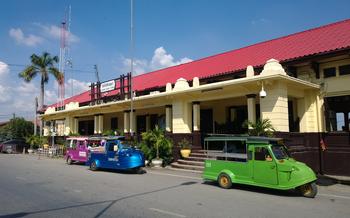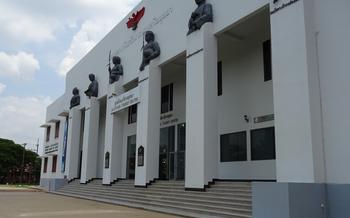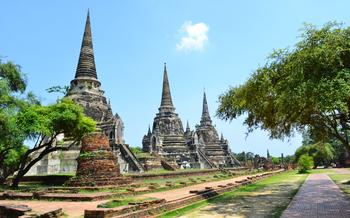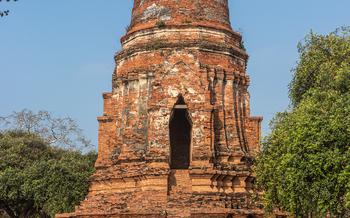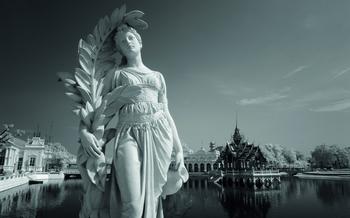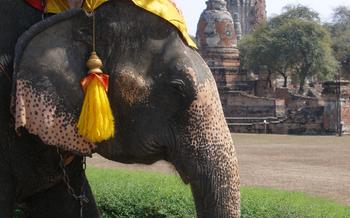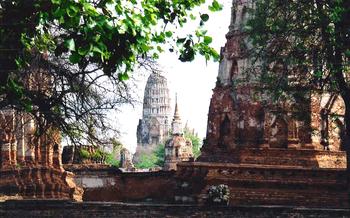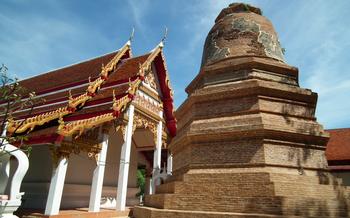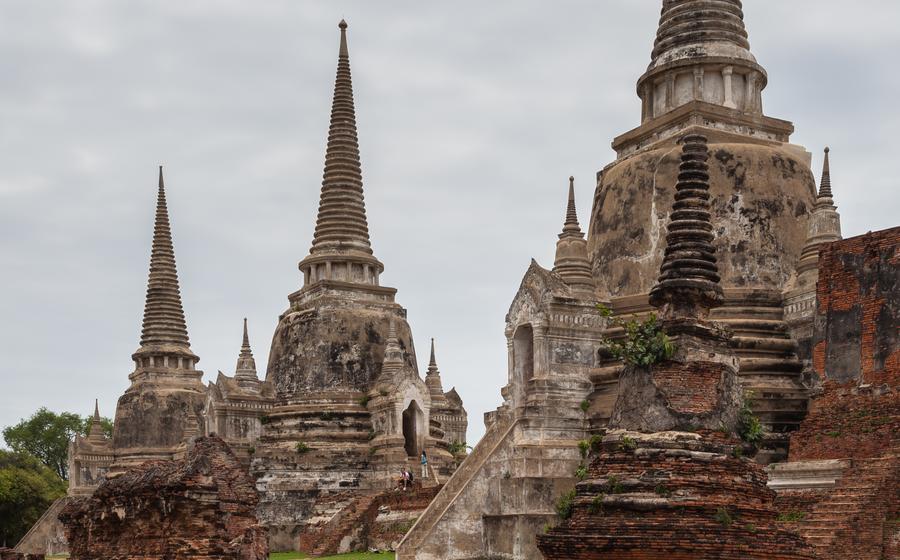
Wat Phra Si Sanphet
- Wat Phra Si Sanphet: A Historical Overview
- Exploring the Ruins of Wat Phra Si Sanphet
- Marveling at the Buddha Images
- The Legend of King Naresuan
- Ayutthaya Historical Park
- Photography and Videography
- Tips for Exploring the Temple
- Nearby Attractions
- Combining History with Nature
- Local Cuisine and Dining Options
- Shopping and Souvenirs
- Insider Tip: Hidden Gems of Wat Phra Si Sanphet
Wat Phra Si Sanphet: A Historical Overview
Wat Phra Si Sanphet, a testament to Thailand's rich history and architectural prowess, stands as one of Ayutthaya's most significant landmarks. Built in the 14th century during the reign of King Ramathibodi I, the temple served as the royal temple of the Ayutthaya Kingdom for over 400 years. Its name, which translates to "Temple of the Holy Sword of Victory," reflects its deep connection to the kingdom's military triumphs and royal ceremonies.
The temple's architectural grandeur is a testament to the Ayutthaya Kingdom's artistic and engineering achievements. Its central prang, or main tower, rises majestically, symbolizing Mount Meru, the abode of the gods in Buddhist cosmology. Surrounding the prang are eight smaller stupas, each adorned with intricate carvings and representing the eight directions of the compass.
Wat Phra Si Sanphet's historical significance extends beyond its physical beauty. It played a pivotal role in Thai history, serving as a royal chapel and a venue for important ceremonies, including coronations and royal weddings. The temple's grandeur and sacredness made it a symbol of the Ayutthaya Kingdom's power and prestige. Its destruction during the Burmese invasion of 1767 marked the end of an era, leaving behind a legacy of architectural wonders and historical significance.
Exploring the Ruins of Wat Phra Si Sanphet
The main prang, or central tower, of Wat Phra Si Sanphet stands as an awe-inspiring testament to the temple's grandeur. Its towering height and intricate architectural details, such as the delicate stucco work and gleaming glazed tiles, showcase the exceptional craftsmanship of Ayutthaya's artisans. The prang symbolizes Mount Meru, the sacred mountain in Buddhist cosmology, and is believed to contain relics of the Buddha.
Surrounding the main prang are a series of eight smaller stupas, each adorned with exquisite carvings and vibrant murals. These stupas represent the eight arahants, or enlightened disciples of the Buddha, and contain ashes from the royal cremations that took place at the temple. The stupas stand as a reminder of the deep reverence and devotion that the Thai people have for Buddhism.
Within the temple grounds, visitors can also explore the remains of the ordination hall and viharas, or assembly halls. These structures once served as places for monks to gather for religious ceremonies, meditation, and teachings. Although largely in ruins, the surviving fragments of walls, pillars, and intricate carvings provide a glimpse into the temple's former glory and the vibrant monastic life that took place within its walls.
Marveling at the Buddha Images
Wat Phra Si Sanphet is home to a remarkable collection of Buddha images, each with its own unique story and significance. The most awe-inspiring is undoubtedly the colossal Buddha statue enshrined within the main prang. Towering over the temple grounds, this majestic figure exudes an aura of serenity and divinity. Its intricate details, from the finely carved robes to the serene facial expression, are a testament to the exceptional craftsmanship of the Ayutthaya period.
The surrounding stupas also house smaller Buddha images, each with its own unique characteristics. Some depict the Buddha in different postures, such as the seated meditation posture or the standing posture with one hand raised in blessing. Others showcase different mudras, or hand gestures, each representing a specific aspect of the Buddha's teachings. The diversity of these Buddha images reflects the rich iconography of Thai Buddhism and the devotion of the Ayutthaya people.
Beyond their artistic and historical value, the Buddha images at Wat Phra Si Sanphet hold deep spiritual significance for Thai people. They are not merely objects of worship but are believed to embody the presence of the Buddha himself. Devotees often come to the temple to pay their respects, offer prayers, and seek blessings from these sacred images. The serene atmosphere and the palpable devotion that permeates the air create a truly spiritual and uplifting experience for visitors.
The Legend of King Naresuan
Wat Phra Si Sanphet is not only a testament to Ayutthaya's architectural prowess but also holds a special place in Thai history and folklore. The temple is inextricably linked to the legend of King Naresuan, one of Thailand's most revered monarchs.
According to legend, King Naresuan, who ruled Ayutthaya in the late 16th century, was captured by the Burmese as a child and taken to their capital, Pegu. He spent years in captivity, learning the Burmese language and military tactics. In 1584, he managed to escape and return to Ayutthaya, where he raised an army to challenge the Burmese.
The two armies met in a fierce battle at the Battle of Nong Sarai, just outside Ayutthaya. King Naresuan, mounted on his war elephant, engaged in single combat with the Burmese crown prince, Mingyi Swa. In a dramatic and iconic moment, Naresuan slew Mingyi Swa with his sword, turning the tide of the battle in favor of the Thais.
The victory at Nong Sarai marked a turning point in the history of Ayutthaya. It not only secured the kingdom's independence but also established King Naresuan as a legendary figure in Thai history. The legend of his bravery, cunning, and patriotism continues to inspire Thais to this day.
Wat Phra Si Sanphet played a significant role in the legend of King Naresuan. It was here that he returned to Ayutthaya after his escape from Pegu and where he gathered his forces before the Battle of Nong Sarai. The temple also served as a place of celebration and thanksgiving after the victory.
The legend of King Naresuan is depicted in a series of murals on the walls of Wat Phra Si Sanphet. These murals, which date back to the 17th century, vividly portray the key events of the legend, including Naresuan's capture, his escape, the Battle of Nong Sarai, and his triumphal return to Ayutthaya.
The legend of King Naresuan is a powerful reminder of the courage, resilience, and patriotism of the Thai people. It is a story that is deeply ingrained in Thai culture and identity, and Wat Phra Si Sanphet stands as a testament to its enduring legacy.
Ayutthaya Historical Park
In 1969, the Thai government recognized the immense historical and cultural significance of Ayutthaya and established the Ayutthaya Historical Park. This park encompasses approximately 289 hectares of land, including the ruins of Wat Phra Si Sanphet and numerous other temples, palaces, and fortifications.
The establishment of the historical park was a pivotal moment in preserving Thailand's rich history and cultural heritage. It has allowed for the conservation and restoration of the ancient ruins, ensuring their preservation for future generations.
Within the park, visitors can explore the remains of over 60 temples, each with its unique architectural style and historical significance. These temples offer a glimpse into the grandeur and opulence of the Ayutthaya Kingdom, showcasing the artistic and religious achievements of the era.
The park also features the ruins of palaces, city gates, and fortifications, providing insights into the urban planning and defensive strategies of the ancient city. These structures tell the story of a thriving metropolis that once served as the political and cultural center of the kingdom.
The Ayutthaya Historical Park is a testament to the enduring legacy of the Ayutthaya Kingdom. It is a place where history comes alive, allowing visitors to immerse themselves in the grandeur of a bygone era and gain a deeper appreciation for Thailand's rich cultural heritage.
Photography and Videography
Wat Phra Si Sanphet, with its majestic ruins and serene atmosphere, presents a captivating subject for photographers and videographers. While capturing the beauty of the temple is encouraged, visitors must adhere to the following guidelines to ensure respect and preservation.
-
Designated Areas: Photography and videography are permitted within the temple grounds, but certain areas may be restricted due to their sacred nature or ongoing restoration work. Please observe the signs and instructions provided by the temple authorities.
-
Flash Photography: The use of flash photography is generally discouraged within the temple, as it can be disruptive to other visitors and potentially damage the delicate murals and artifacts. Natural light photography is preferred to preserve the authenticity and ambiance of the site.
-
Respectful Imagery: When capturing images of the Buddha statues, it is important to maintain a respectful and dignified approach. Avoid posing or taking disrespectful shots that may be culturally insensitive or offensive. Focus on capturing the essence and serenity of the Buddha's presence.
Tips for Exploring the Temple
Exploring Wat Phra Si Sanphet is a journey through history and spirituality. To make the most of your visit, consider the following tips:
-
Early Morning or Late Afternoon Visit: Avoid the midday heat by visiting the temple early in the morning or late in the afternoon. The golden light of these times also enhances the beauty of the ruins.
-
Guided Tours or Audio Guides: Guided tours are available in various languages, providing insightful commentary on the temple's history and significance. Audio guides are also available for self-paced exploration.
-
Self-Guided Exploration: For a more intimate experience, explore the temple at your own pace. Study the ruins, read the informative plaques, and let the tranquility of the surroundings envelop you.
-
Photography and Respect: While photography is permitted in most areas, be mindful of the sacred nature of the site. Avoid using flash photography near the Buddha images, and always ask for permission before photographing people.
-
Comfortable Footwear: The temple grounds involve uneven terrain and steps, so wear comfortable shoes for easy exploration.
-
Stay Hydrated: Ayutthaya can be hot and humid, so carry water or purchase it from vendors within the historical park.
-
Mindful Exploration: Remember that Wat Phra Si Sanphet is an active religious site. Be respectful of worshippers, maintain silence in designated areas, and avoid climbing or touching the Buddha images.
Nearby Attractions
Beyond the captivating ruins of Wat Phra Si Sanphet, Ayutthaya offers a wealth of other historical and cultural landmarks to explore. The ancient city boasts several other impressive temples and ruins, including Wat Mahathat with its iconic Buddha head entwined by tree roots, Wat Chaiwatthanaram with its unique blend of Khmer and Thai architectural styles, and Wat Yai Chai Mongkol with its giant reclining Buddha.
Immerse yourself in the vibrant local culture by attending traditional Thai performances and events. The Ayutthaya Historical Park hosts regular cultural shows showcasing traditional Thai dance, music, and martial arts. Don't miss the chance to witness these captivating performances that bring Thai history and heritage to life.
Indulge in the culinary delights of Ayutthaya by exploring the bustling local markets. Sample the mouthwatering street food, from fragrant curries and noodle dishes to tropical fruits and sweets. Vegetarian and vegan travelers will find plenty of delicious options, including fresh produce, tofu-based dishes, and meat alternatives.
Support local artisans and businesses by purchasing unique handicrafts and souvenirs. Ayutthaya's markets and shops offer a diverse selection of handmade goods, including intricate wood carvings, colorful pottery, and delicate silk textiles. Remember to bargain politely and respectfully to get the best prices.
Combining History with Nature
Wat Phra Si Sanphet is not just a historical site; it is also surrounded by lush greenery and natural beauty. The temple complex is nestled within the Ayutthaya Historical Park, which encompasses over 200 acres of parks and gardens. Visitors can take a leisurely stroll through the park, admiring the towering trees, colorful flowers, and tranquil ponds. The park is also home to a variety of wildlife, including birds, squirrels, and lizards. Visitors can enjoy birdwatching or simply relax in the peaceful surroundings.
For those who want to combine history with nature, there are several options available. Visitors can take a boat ride along the Chao Phraya River, which offers stunning views of the temple complex and the surrounding countryside. They can also explore the nearby Bang Pa-In Royal Palace, which features beautiful gardens and pavilions set amidst a picturesque lake.
Whether you are a history buff, a nature lover, or simply looking for a relaxing day out, Wat Phra Si Sanphet and the surrounding Ayutthaya Historical Park have something to offer everyone.
Local Cuisine and Dining Options
Exploring the culinary delights of Ayutthaya is a must-do for any visitor. The city offers a diverse range of dining options, from traditional Thai cuisine to international fare. For a truly authentic experience, be sure to sample some of the local dishes, such as khao soi, a rich and flavorful coconut-based curry noodle soup, or boat noodles, a smaller version of the traditional noodle soup with a variety of toppings.
For vegetarians and vegans, there are plenty of options available, including pad pak bung, a stir-fried morning glory with garlic and soy sauce, or tom yum hed, a spicy and sour mushroom soup. Be sure to try some of the fresh tropical fruits, such as mango, papaya, and pineapple, which are in abundance in Thailand.
When it comes to dining options, there are plenty of choices to suit every budget. For a casual and affordable meal, try one of the many street food stalls, where you can sample a variety of local dishes for a fraction of the price of a restaurant.
If you're looking for a more upscale experience, there are several fine dining restaurants in Ayutthaya that offer a sophisticated take on Thai cuisine. No matter what your budget or preferences, you're sure to find something to tantalize your taste buds in this vibrant city.
Shopping and Souvenirs
When visiting Wat Phra Si Sanphet, you'll have the opportunity to immerse yourself in the vibrant local culture and take home unique souvenirs. Ayutthaya is renowned for its exquisite handicrafts, intricate carvings, and beautifully woven textiles. Whether you're looking for traditional Thai souvenirs or contemporary creations, you'll find an array of treasures to choose from.
As you stroll through the bustling markets and shops, be sure to engage in the local tradition of bargaining. It's a friendly and respectful way to interact with vendors and secure the best prices. Remember to be polite and patient, and don't be afraid to walk away if you're not happy with the price.
To support local artisans and businesses, consider purchasing directly from the craftspeople themselves. You'll find artisans demonstrating their skills in the markets and workshops, offering a glimpse into the creative process behind each unique piece.
Some of the must-buy souvenirs from Ayutthaya include intricately carved Buddha images, delicate silk scarves, hand-painted ceramics, and jewelry adorned with precious stones. Whether you're looking for a meaningful memento of your trip or a special gift for loved ones back home, you're sure to find something that captures the essence of Ayutthaya.
Insider Tip: Hidden Gems of Wat Phra Si Sanphet
Beyond the main attractions of Wat Phra Si Sanphet, there are hidden gems waiting to be discovered by curious explorers. Venture off the beaten path and uncover secret passageways that lead to hidden chambers, each holding its own unique story.
One such hidden gem is a small shrine tucked away in the far corner of the temple complex. Dedicated to a revered local spirit, this shrine is adorned with colorful offerings and exudes an aura of mysticism. Visitors can pay their respects and learn about the legends surrounding this enigmatic figure.
Another hidden gem is a series of underground tunnels that are said to have been used by the ancient kings as escape routes in times of danger. Explore these subterranean passages and imagine the footsteps of royalty echoing through the centuries.
As you wander through the ruins, keep an eye out for intricate carvings and inscriptions hidden among the crumbling walls. These hidden details offer glimpses into the artistry and craftsmanship of the past, providing a deeper connection to the temple's rich history.
Unveiling the hidden gems of Wat Phra Si Sanphet is like embarking on a treasure hunt, where each discovery brings a sense of wonder and excitement. Embrace the spirit of exploration and let the temple's secrets unfold before you.
